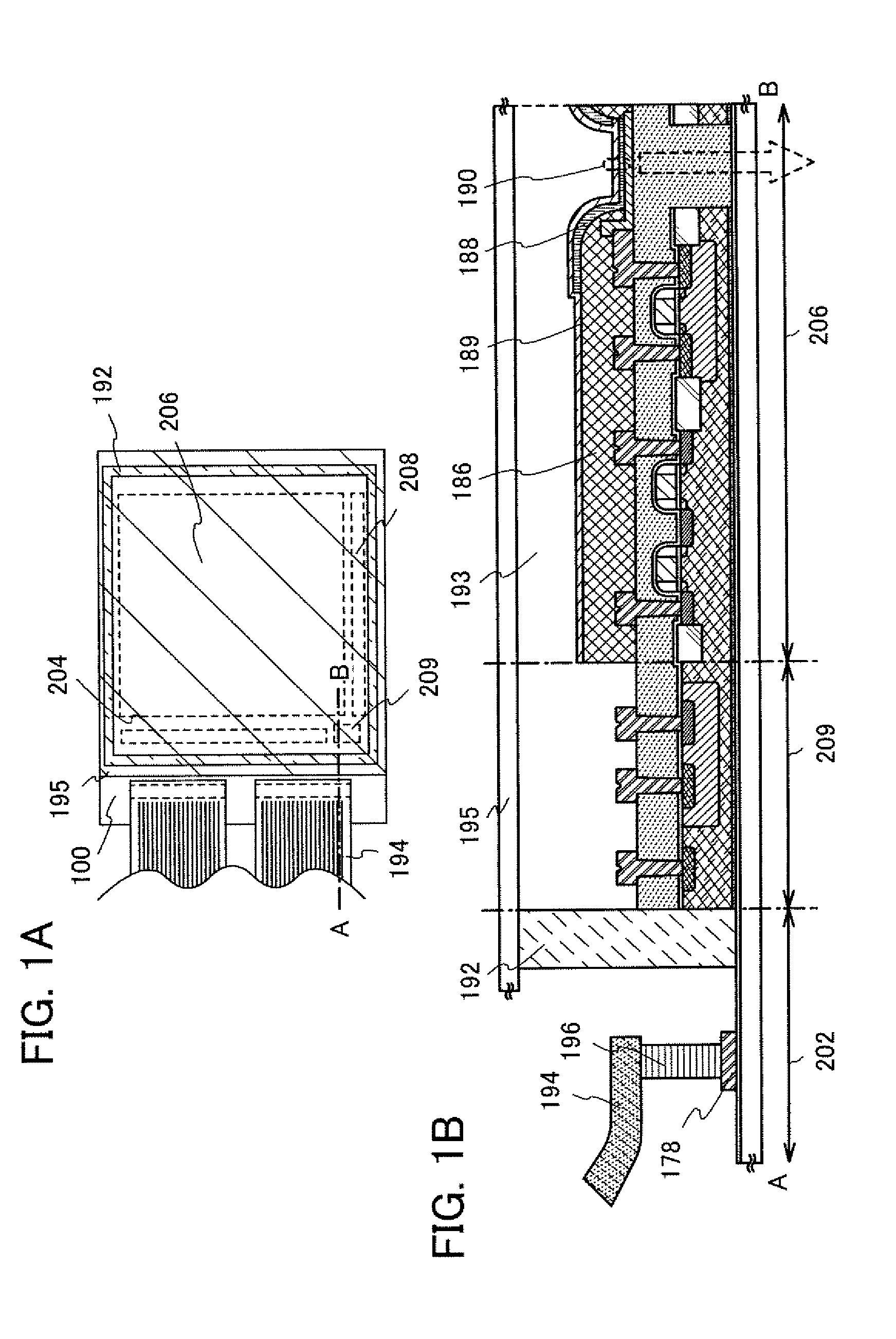Display device
a display device and display technology, applied in the field of display devices, can solve the problems of reducing reliability and yield, affecting display quality, and difficult to obtain a completely uniform crystallization state of polycrystalline silicon, so as to prevent display unevenness, reduce image quality, and high image quality
- Summary
- Abstract
- Description
- Claims
- Application Information
AI Technical Summary
Benefits of technology
Problems solved by technology
Method used
Image
Examples
embodiment mode 1
[0046]In this embodiment modes a display device for high image quality and high reliability and a method for manufacturing the display device will be described in detail with reference to FIGS. 1A and 1B, 2A to 2C, 3A to 3C, 4A to 4C, 5A to 5C, 6A to 6D, 7A to 7C, 9A and 9B and 10A to 10C.
[0047]FIG. 10A is a top view illustrating a structure of a display panel of the present invention. A pixel region 2701 in which pixels 2702 are arranged in matrix, a scan line input terminal 2703, a signal line input terminal 2704, and a reference circuit 2705 are formed over a substrate 2700 having an insulating surface. The number of pixels may be decided according to various standards: if the standard is XGA, the number of pixels may be 1024×768×3 (RGB); if the standard is UXGA, the number of pixels may be 1600×1200×3 (RGB); and if the display panel is for full-spec high vision, the number of pixels may be 1920×1080×3 (RGB).
[0048]A scan line extended from the scan line input terminal 2703 and a ...
embodiment mode 2
[0145]A display device having a light-emitting element can be formed by applying the present invention. Light is emitted from the light-emitting element by any of bottom emission, top emission, and dual emission. In this embodiment mode, an example of a dual emission display device which is for achieving high reliability and has a high-quality display function with excellent visibility will be described with reference to FIG. 8.
[0146]A display device shown in FIG. 8 includes a light-transmitting element substrate 1600 having an insulating surface, a blocking layer 1601, an insulating layer 1604 having a bonding surface, a single-crystal semiconductor layer 1602, transistors 1655, 1665, 1675, and 1685, a bipolar transistor 1640, a first electrode layer 1617, an electroluminescent layer 1619, a second electrode layer 1620, a filler 1622, a sealant 1632, insulating films 1611 and 1612, an insulating layer 1614, a sealing substrate 1625, a terminal electrode layer 1681, an anisotropic c...
embodiment mode 3
[0159]This embodiment mode will describe an example of a display device for achieving high image quality and high reliability. Specifically, a light-emitting display device using a light-emitting element for a display element will be described.
[0160]In this embodiment mode, structures of light-emitting elements that can be used for display elements in the display device of the present invention will be described with reference to FIGS. 13A and 13B.
[0161]FIGS. 13A and 13B illustrate structures of a light-emitting element in which an EL layer 860 is sandwiched between a first electrode layer 870 and a second electrode layer 850. The EL layer 860 includes a first layer 804, a second layer 803, and a third layer 802 as shown in the drawings. In FIGS. 13A and 13B, the second layer 803 is a light-emitting layer, and the first layer 804 and the third layer 802 are functional layers.
[0162]The first layer 804 is a layer having a function of transporting holes to the second layer 803. In FIGS...
PUM
 Login to View More
Login to View More Abstract
Description
Claims
Application Information
 Login to View More
Login to View More - R&D
- Intellectual Property
- Life Sciences
- Materials
- Tech Scout
- Unparalleled Data Quality
- Higher Quality Content
- 60% Fewer Hallucinations
Browse by: Latest US Patents, China's latest patents, Technical Efficacy Thesaurus, Application Domain, Technology Topic, Popular Technical Reports.
© 2025 PatSnap. All rights reserved.Legal|Privacy policy|Modern Slavery Act Transparency Statement|Sitemap|About US| Contact US: help@patsnap.com



